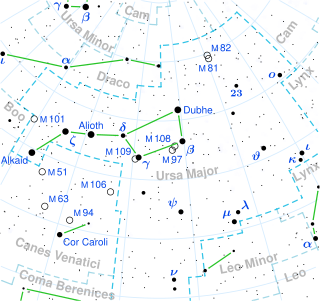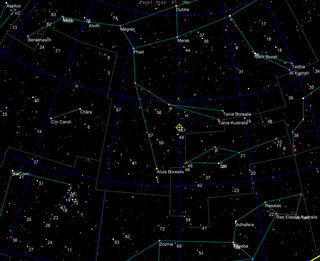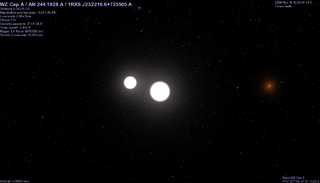
W Ursae Majoris is the variable star designation for a binary star system in the northern constellation of Ursa Major. It has an apparent visual magnitude of about 7.9, which is too faint to be seen with the naked eye. However, it can be viewed with a small telescope. Parallax measurements place it at a distance of roughly 169 light years (52 parsecs) from Earth.

Alpha Ursae Majoris, formally named Dubhe, is, despite being designated "α" (alpha), the second-brightest object in the constellation of Ursa Major.

47 Ursae Majoris, formally named Chalawan, is a yellow dwarf star approximately 46 light-years from Earth in the constellation of Ursa Major. As of 2011, three extrasolar planets are believed to orbit the star.

Omicron Ursae Majoris, formally named Muscida, is a star system in the northern circumpolar constellation of Ursa Major. It has an apparent visual magnitude of +3.35 and is located at a distance of around 179 light-years from the Sun. In 2012, an extrasolar planet, designated Omicron Ursae Majoris Ab was found to be orbiting the primary.

Kappa Ursae Majoris is a binary star in the constellation of Ursa Major. With a combined apparent magnitude of +3.60, the system is approximately 358 light-years from Earth.

Xi Ursae Majoris, also named Alula Australis, is a star system in the constellation of Ursa Major. On May 2, 1780, Sir William Herschel discovered that this was a binary star system, making it the first such system ever discovered. It was the first visual double star for which an orbit was calculated, when it was computed by Félix Savary in 1828. It is also a variable star with a small amplitude. Xi Ursae Majoris is found in the left hind paw of the Great Bear.

Omega Ursae Majoris is the Bayer designation for a binary star system in the northern circumpolar constellation of Ursa Major. It is visible to the naked eye with an apparent visual magnitude of 4.61. Based upon an annual parallax shift of 13.24 mas, it is roughly 246 light years from the Sun. At that distance, the visual magnitude of the star is diminished by an extinction factor of 0.11 due to interstellar dust.

47 Ursae Majoris b, formally named Taphao Thong, is a gas planet and an extrasolar planet approximately 46 light-years from Earth in the constellation of Ursa Major. The planet was discovered located in a long-period orbit around the star 47 Ursae Majoris in January 1996 and as of 2011 it is the innermost of three known planets in its planetary system. It has a mass at least 2.53 times that of Jupiter.
39 Cygni is a binary star system near the southern border of the northern constellation of Cygnus, approximately 250 light years away from Earth. It is visible to the naked eye as an orange-hued star with an apparent visual magnitude of 4.43. The system is moving closer to the Sun with a heliocentric radial velocity of −17 km/s.
36 Ursae Majoris is a double star in the northern constellation of Ursa Major. With an apparent visual magnitude of 4.82, it can be seen with the naked eye in suitable dark skies. Based upon parallax measurements, this star lies at a distance of 41.7 light-years from Earth.
S Antliae is a W Ursae Majoris-type eclipsing binary star in Antlia.

Y Sextantis, abbreviated as Y Sex, is a variable star system in the equatorial constellation of Sextans. The system is invisible to the naked eye with a mean apparent visual magnitude of 9.88. It is located roughly at 1,300 light years from the Sun based on parallax.

WZ Cephei is an eclipsing binary star of W Ursae Majoris-type in the constellation of Cepheus, located 880 light years away from the Sun. The stars orbit around a common orbital barycenter every 0.41744 days. Timing analyses have revealed the possible presence of a third low-mass stellar companion in a wide orbit.

Sigma2 Ursae Majoris is a binary star in the constellation of Ursa Major. Parallax measurements made by the Hipparcos spacecraft put it at a distance of about 66.5 light years from Earth, making this a fairly nearby system. The primary component has an apparent magnitude of about 4.8, meaning it can be seen with the naked eye (see Bortle scale).
HD 132563 is a triple star system in the constellation Boötes. The two resolvable components of this system are designated HD 132563 AC and HD 132563 B. The primary star, HD 132563 AC, is actually a spectroscopic binary with a period of more than 15 years and an orbital eccentricity of greater than 0.65. The smaller member of this tightly orbiting pair has about 55% the mass of the Sun.

Phi Ursae Majoris, Latinized from φ Ursae Majoris, is binary star system in the northern constellation of Ursa Major. It is white-hued and is visible to the naked eye with a combined apparent visual magnitude of +4.60; the primary is magnitude 5.28 while the secondary is magnitude 5.39. The system is located at a distance of approximately 510 light years from the Sun based on parallax, but is drifting closer with a radial velocity of −14.7 km/s. It should make its closest approach at a distance of around 370 ly in about 4.7 million years.

RR Centauri is a variable star of apparent magnitude maximum +7.29. It is located in the constellation of Centaurus, approximately 320 light years distant from the solar system.

65 Ursae Majoris, abbreviated as 65 UMa, is a star system in the constellation of Ursa Major. With an apparent magnitude of about 6.5, it is at the limit of human eyesight and is just barely visible to the naked eye. Trigonometric parallax measurements made by the Hipparcos spacecraft put it at a distance of about 690 light years ; this is in close agreement with the dynamical parallax value of 763 ± 95 light-years (234 ± 29 pc).
V752 Centauri is multiple star system and variable star in the constellation of Centaurus. An eclipsing binary, its apparent magnitude has a maximum of 9.10, dimming to 9.66 during primary eclipse and 9.61 during secondary eclipse. Its variability was discovered by Howard Bond in 1970. From parallax measurements by the Gaia spacecraft, the system is located at a distance of 410 light-years from Earth.
VW Leo Minoris is a tight quadruple star system, located in the constellation of Leo Minor. With a peak combined apparent visual magnitude of 8.07, it is too faint to be seen with the naked eye. Parallax measurements give a distance estimate of approximately 360 light years from the Sun, and it is drifting further away with a radial velocity of +5 km/s.






